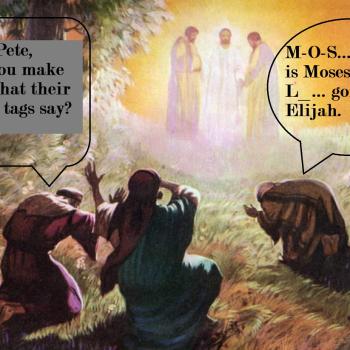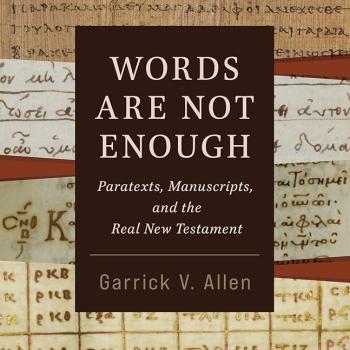My blogging through Earl Doherty’s book Jesus: Neither God Nor Man continues here with chapter 6. For those who wish to read a post trying to put a positive spin on the weak and unpersuasive claims in this chapter, Neil Godfrey has what you are looking for on his blog Vridar. What I will offer here is a discussion of why the chapter, like the rest of the book so far, represents when at its best unconvincing arguments and unsubstantiated claims about its subject matter, and at its worst, tactics you may be familiar with from other examples of apologetics in the worst sense of that term.
The chapter begins with the letters of Ignatius, arguing against Docetism, a viewpoint which, as far as we can tell, never involved a denial that Jesus appeared in human history, but simply, as a result of the development of belief in his divinity, a denial of his genuine humanity. Doherty also notes that Ignatius knows biographical details about Jesus, even though he does not show clear signs of knowing written Gospels such as those that made it into the New Testament (pp.57-58). That these considerations might themselves provide reasons for drawing a conclusion different than the one Doherty is heading for is never considered.
Doherty proceeds to consider details from the Gospels that he considers it surprising Paul and other epistle writers never mention in their letters. Often his response to the material borders on the bizarre. Why is it surprising that the later and clearly legendary details in the infancy stories in Matthew and Luke are not reflected in earlier literature? It is unsurprising to mainstream historical scholarship, which is familiar with countless examples of the same phenomenon, namely the development of mythologized birth stories around a historical figure.
There follows after that an attempt to derive from Paul’s silence about whether Jesus was circumcised an argument in support of mythicism. It seems that Doherty has failed to familiarize himself even at a superficial level with the debates that Paul was engaged in, which were about the question of whether Gentiles who became Christians had to be circumcised. That Jesus and all his earliest followers, including Paul, were Jewish and had been circumcised when they were eight days old was not relevant to resolving that issue, for reasons that should be obvious. Paul nowhere advocates reversal of circumcision for Jews.
Doherty then moves on to what is the highlight of the chapter in its “breathtaking inanity” (if I may borrow a phrase from Judge Jones). One piece of evidence in favor of there having been a historical Jesus is the fact that Paul, our earliest Christian source, makes reference to having met “James the brother of the Lord” (Galatians 1:19). Doherty is determined to find a way to avoid the plain meaning of such language at any cost, even if it means positing that the phrase meant “the brother of God” – a concept for which we have no evidence either in Judaism or Christianity (p.60).
A substantial amount of space is dedicated to trying to get the reader to not notice that the terminology “brother(s) of the Lord” and “brother(s) in the Lord” are distinct in meaning, and clearly so. It is not the same thing to speak of “the Nigerian president in the United States” as to speak of “the Nigerian president of the United States.” Nor is it the same thing to speak of “father in the modern military” and “father of the modern military.” I could go on, but I trust that readers know enough of at least one language to be able to notice Doherty’s sleight of hand. The careful reader is forced to choose between Doherty’s being an incompetent reader of Paul’s letters and his being a deceitful manipulator of them. Either way, I cannot imagine why anyone would choose to accept his claims or fall for his misdirection. The attempt to treat the reference to “James the brother of the Lord” as simply one more example of the use of “brother” for all Christian believers fails, because it does not do justice to what Paul actually wrote.
And so, if one is convinced that the phrase means what it clearly seems to, Doherty has other “solutions” – for instance, one can always assume it is a later interpolation, in spite of there being no manuscript evidence to support this. Doherty rightly points out that our earliest manuscripts are somewhat later rather than original copies (pp.61-63). But this is true of pretty much all our ancient texts, and so unless one is going to propose a moratorium on all historical reconstruction, historians must continue to draw the best conclusions they can based on the evidence available. And to his credit, Doherty acknowledges that the attempt to chalk matters up to changes to manuscripts, which were made before our earliest copies and which left no trace in the extant manuscripts, cuts both ways (p.62). It is as easy to posit that references to a historical, flesh-and-blood Jesus were later excised as that references to a historical, flesh-and-blood Jesus were added. Either we work with the available evidence or we remain agnostic until we find original manuscripts and/or unambiguous archaeological evidence for past events. In neither case does one end up with a basis for concluding that mythicism is more probable than mainstream historical scholarship’s conclusions.
All that we have discussed might well be enough to make clear that mythicism does not reflect or represent a well-informed, scholarly approach to the question of the historical Jesus. But Doherty is not done illustrating this just yet. Next he turns to lack of information about “Jesus’ personal life” in the epistles. Such details are also absent from the Gospels, which Doherty believes later attempted to turn a celestial Jesus into a historical one, and their absence even from allegedly historicizing sources ought to have given him pause. At any rate, Doherty’s utter lack of awareness of the characteristics of ancient literature (Acts lacks similar details about Paul and the other early followers of Jesus) and, even more so, the realities of ancient life for ordinary people, is astounding. He even goes so far as to point out that “We know not the slightest feature about him, his living accommodations, how he dressed, his tastes in anything from food to recreation” (p.63). Doherty is allowing his modern common sense to be his guide, as he states explicitly. But common sense is not a reliable guide to the realities of ancient life, and what one can expect to be mentioned regarding people who for the most part had no time for recreation and no choice about what they ate or what they wore.
Doherty compares the Gospels to John Bunyan’s Pilgrim’s Progress (p.64). Having read both, I can scarcely believe that Doherty has read both as well, or that he intends this comparison to be taken seriously. That he finds the character of Jesus two-dimensional, whether you agree with him or not, is probably a result of the Gospels’ typically ancient lack of interest in characters’ psychology. That the Gospel authors at times make Jesus a mouthpiece for their own understanding is often noted by mainstream scholarship and thus not in any obvious way an argument for mythicism.
Doherty next turns attention to the lack of miracles attributed to Jesus in the epistles. If these are a later legendary development, as Doherty is aware that mainstream historical scholarship concludes, then there is a perfectly legitimate explanation (pp.66-67). But let us not let Doherty off the hook even that easily. Surely if absence of miracles is an issue, then that is as true in the case of a mythical Jesus as a historical one, if not more so. If we should expect Paul to mention miracles performed by a historical Jesus who may not have done them or at least may not have done as many or as impressive ones as later Gospels would claim, then should we not expect him to recount the healing that ancient people always expected from their divine saviors? But like many apologists for a range of views, Doherty is not interested in logically evaluating evidence, nor considering all possible interpretations and working out which is best, but offering any and all arguments he can in favor of mythicism, no matter how weak or unpersuasive, or – as in this case – how much they work at least as well against mythicism as for it.
Doherty continues with an attempt to eliminate the significance of the reference to Jesus having “suffered outside the gate” in Hebrews, and concludes with mention of the Lord’s Supper as found in the Didache, as usual without seeming to recognize how the connection of Jesus with David, there as in the New Testament, would have been understood by ancient Jews.
Any attentive reader of Doherty’s book, especially one who is actually familiar with historical study and/or what we know about ancient Judaism and/or Christian origins, would realize that they are being taken for a ride. Unfortunately, as often happens with the natural sciences, so too with history, there are many who lack the familiarity with genuine scholarship necessary to detect obvious imitations.












